This fermented honey garlic is the perfect thing to make to boost your immune system! Both honey and garlic have strong medicinal benefits, so you’ll want to have this delicious home remedy on hand for cold and flu season.
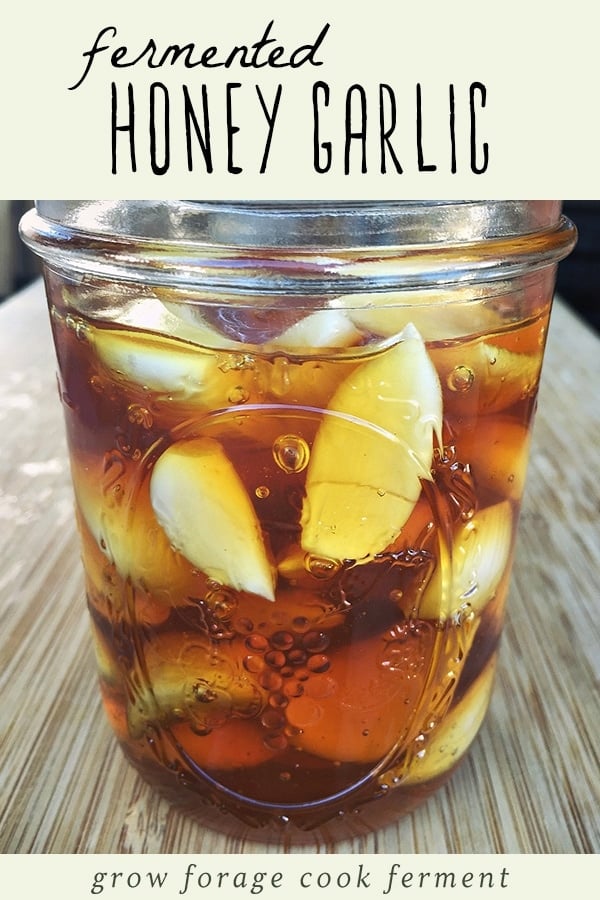
Want to save this post for later?
Fermenting Garlic in Honey
I’m really excited to share this post with you! Fermented honey garlic is something I’ve been wanting to try for a very long time, ever since I first read about it on the Killer Pickles blog.
I usually reserve my honey for mead making, but using it for other ferments intrigued me. Don’t ask me why I haven’t done it until now, because it’s the easiest thing in the world!
This tasty fermented garlic in honey can be used for many things, as good food and good medicine. Honestly though, I like to just eat it as is!
Fermented Honey Garlic Recipe
Making fermented honey garlic is so easy, it hardly needs a recipe!
Prepare the Garlic
The hardest and most time consuming part is prepping all of the garlic. Whatever size jar you use, you’ll want to fill it about 1/2-3/4 full of peeled garlic.
The quickest and easiest way to prep garlic is to place the side of a chef’s knife on top of a single clove and then give it a firm whack with the palm of your hand.
Don’t do it too hard, as you don’t want to crush the garlic, but just enough to lightly bruise the it. This will make it easy to peel, and will also release a bit of the garlic juice.
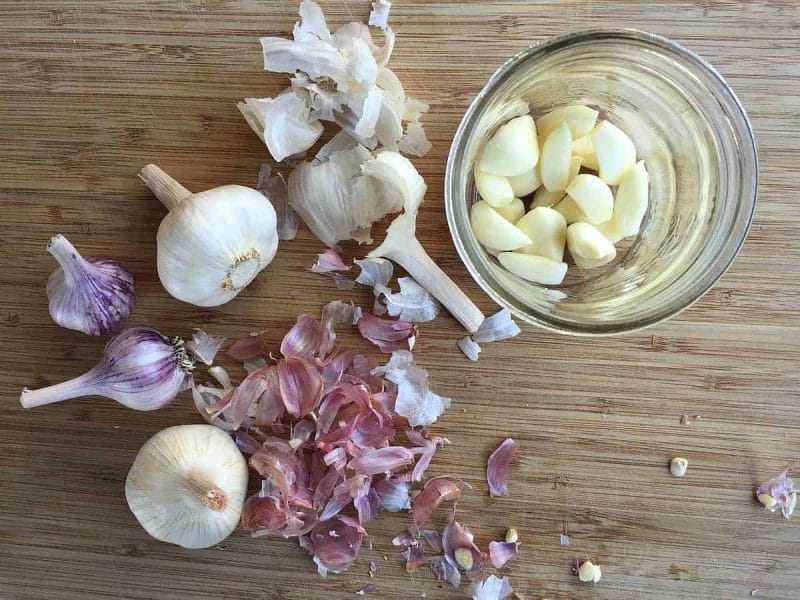
Add the Honey
Once you have enough garlic in your jar, pour in some raw honey to cover it. The garlic will probably float a bit and that’s ok.
It’s important to use raw honey to make fermented garlic in honey, as it will still have all the bacteria and wild yeast that is necessary for fermentation.
When liquid is added to honey, it jump starts the fermentation process. The small amount of juice from the garlic will create just enough liquid for fermentation to happen.
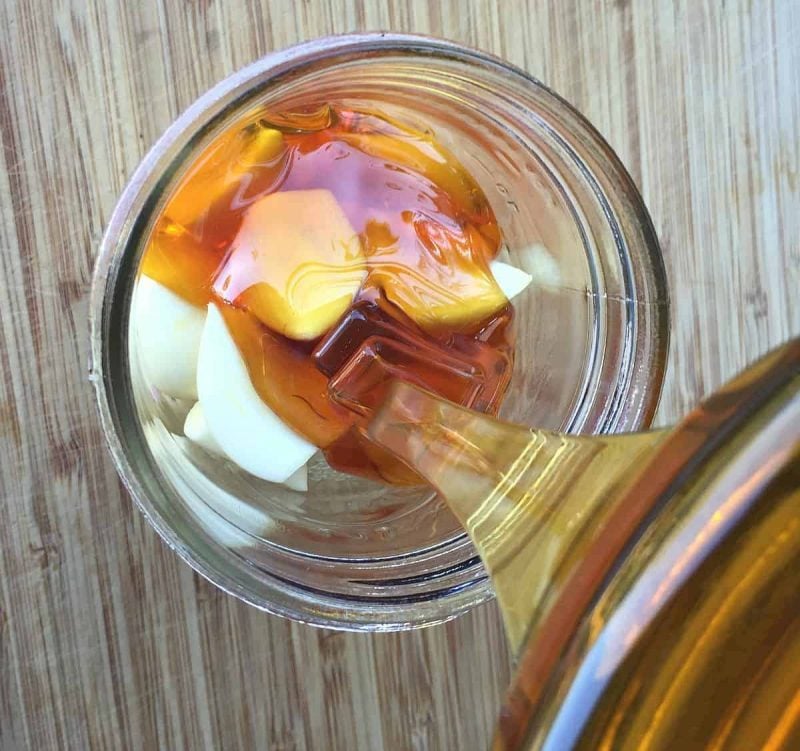
Cover and Flip
Cover the jar loosely with a lid to let the gasses escape, and put it in a dark place to ferment.
It’s a good idea to put a plate or something similar underneath the jar as it’s fermenting, as it will likely bubble up a bit and a little honey could possibly drip out.
It’s also important to gently turn the jar over every day or so, or whenever you think about it, to make sure that all of the garlic stay coated with honey.
Screw the lid on tightly before you do this! Then return it to it’s upright position and re-loosen the lid.
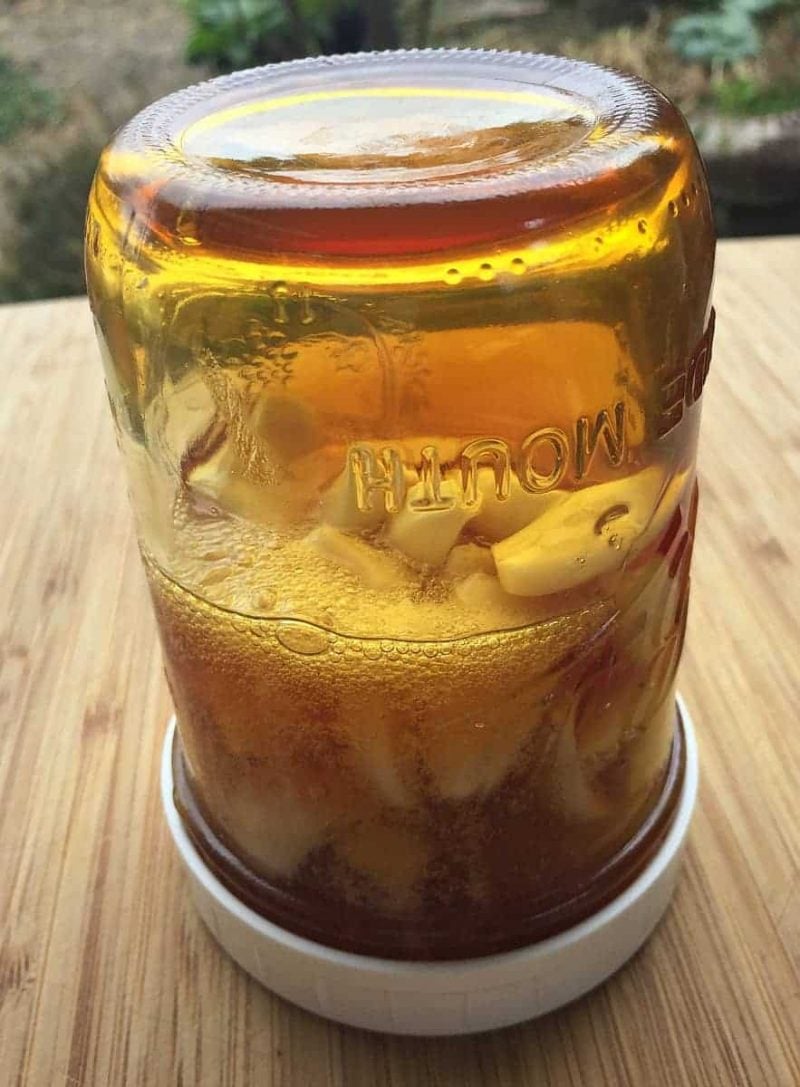
In a few days to a week you will notice some bubbles forming on the surface of the honey. Hooray!
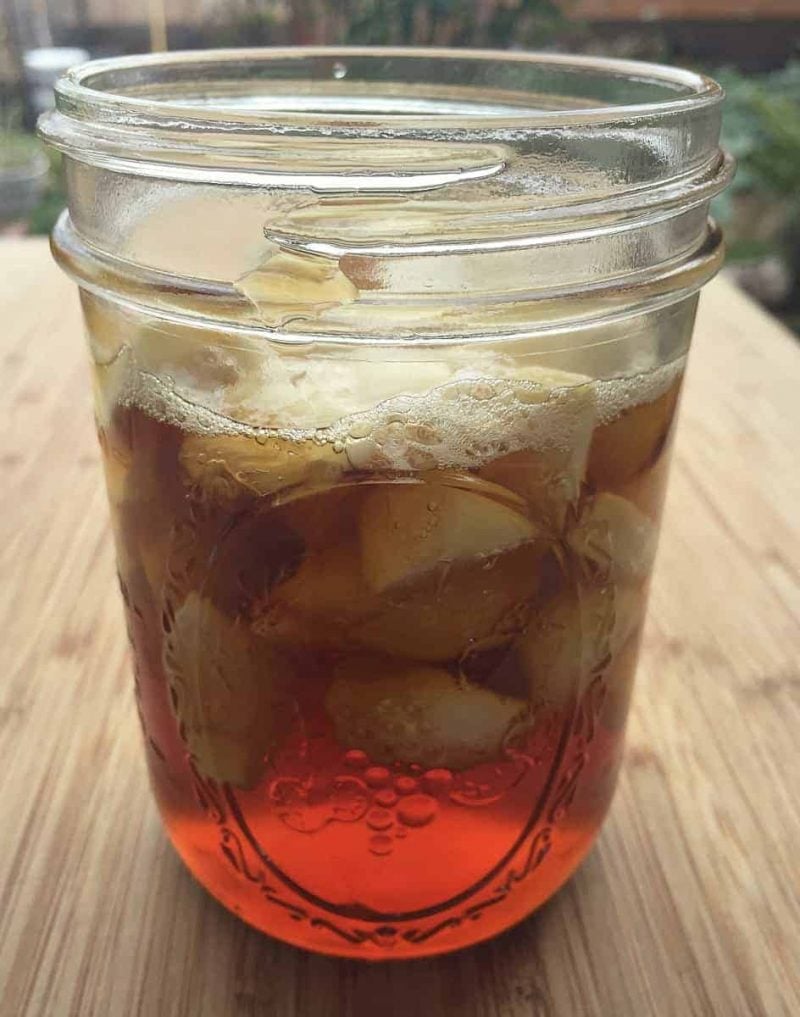
The honey garlic will ferment for about a month, but you can eat it at any time during the process.
The flavor will continue to develop over time, the garlic will mellow, and the honey will become much runnier.
Occasionally the garlic cloves turn a blue or green color due to a reaction during the fermentation process. While it may be a bit alarming, it is not harmful and the honey garlic can still be used.
Honey garlic will store well in a cool place for many months, or even a year or longer! I’ve kept some for over two years and it is still good.
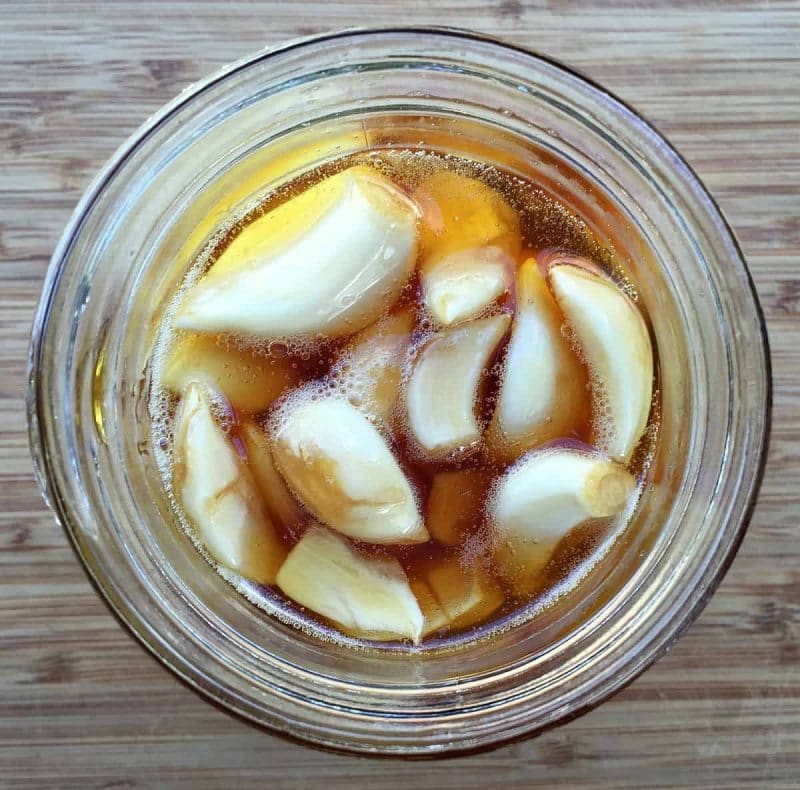
Using Fermented Honey Garlic
Now, how do you use this fermented honey garlic? That’s a good question, and it can be used in a variety of ways.
Both garlic and honey have strong medicinal properties, so it makes sense to use it as an immune booster or if you feel a cold or flu coming on.
Pop a whole garlic clove, or take a spoonful of honey (or both!).
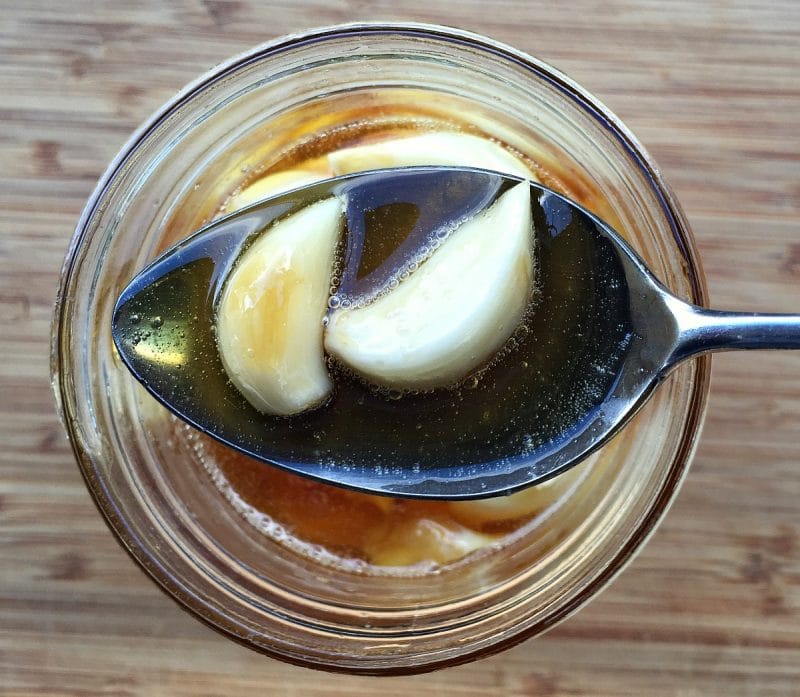
As you can probably imagine, honey garlic also makes a wonderful food!
It’s a natural in marinades and sauces, and would make a really tasty glaze for meats or veggies. Basically anything where you would normally use honey and garlic together!
Is Botulism a Concern in Honey Garlic?
I get this question a lot about fermented honey garlic! The short answer is no, botulism is really not a concern in this type of ferment.
While botulism can happen in garlic and oil preparations without added acidity, the fermentation process that happens here makes it very unlikely.
Raw honey is acidic, and while it can carry botulism spores (which is why it is not recommended for babies under 1 year), the level of acidity stops them from reproducing, which is what causes botulism.
If you are concerned about it, use a pH test strip. Botulism spores can’t reproduce with a pH of less than 4.6. Honey is usually around 3.9, but that can vary between brands.
If the pH is too high, add a splash of raw apple cider vinegar to add more acidity and retest. This is generally not needed, but I did want to mention it.
Honey garlic should not be given to babies under one year of age.
I really hope you make this yummy honeyed garlic! It’s super easy, and great to have on hand. I have a feeling it’s going to become a staple in our house!
Have you ever made fermented honey garlic? How do you use it?
More Fermented and Infused Honey Recipes
Enjoy these other recipes that showcase fermented and infused honey!
- Fermented Honey Cranberries
- Fermented Elderberry Honey
- Herbal Infused Honey
- Lilac Flower Infused Honey
Fermented Honey Garlic
Equipment
Ingredients
- 1 cup whole garlic cloves peeled and slightly crushed
- 1 cup raw honey or more, as needed to cover garlic
Instructions
- Place the peeled garlic cloves into a wide-mouth pint sized mason jar. Add enough honey to completely cover the garlic cloves. Make sure they are coated with honey.
- Place the lid on the jar loosely, then tuck into a dark place.
- Every day or so, tighten the lid on the jar and flip it upside down to coat the garlic cloves with honey. Loosen the lid again when you return it to the upright position.
- Within a few days to a week, you should see small bubbles start to form on the surface of the honey.
- The honey garlic will ferment for about a month, but you can eat it at any time. The flavor will continue to develop over time, the garlic will mellow, and the honey will become much runnier.
- Store in a cool place for many months or even a year, if not longer.
Notes
- It’s important to use raw honey for this recipe, as it has all of the bacteria and wild yeast that is necessary for fermentation.
- The small amount of juice from the garlic will create just enough liquid for fermentation to happen.
- It’s a good idea to put a plate underneath the jar during fermentation, as it will likely bubble up and a little bit of honey could possibly drip out.
- Occasionally the garlic cloves turn a bluish or greenish color during the fermentation process. While it may be a bit alarming, it is not harmful and the honey garlic can still be used.
- If you are concerned about botulism, use a pH test strip. Botulism spores can't reproduce with a pH of less than 4.6. Honey is usually around 3.9, but that can vary between brands.
- If the pH is too high, add a splash of raw apple cider vinegar to add more acidity and retest. This is generally not needed, but I do want to mention it.
- Honey garlic should not be given to babies under one year of age.

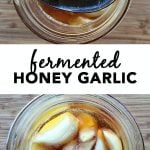
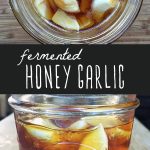
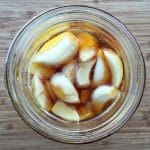

Some of the honey is solidifying in the bottom of my mason jars. What should I do?
I would move it to a warmer location.
Hey :) thankful to have come across this post- I plan on starting a few jars but I’m curious..
after I use up the fermented garlic, do I add fresh garlic to the already fermented old honey juice… or must I use it all up then start fresh all over again?
Thank you
No. You’ll want to start a new batch each time to prevent cross-contamination.
For whatever reason I put this in my refrigerator after making it. Do I need to start a new batch or can I just take it out and put it on the counter?
It’ll resume fermenting once it comes back to room temp on your counter.
Is it okay to consume this on a regular basis let’s say a teaspoon at a time daily
Yup!
I may have messed up on reading the recipe right.. I kept the lid on the past week and kept flipping the jar. Is it still useable? It’s just very bubbly throughout the liquid but doesn’t smell awful.
Hailey, that’s fine, but I would start “burping” it every day because the built-up gases could cause your jar to explode.
I made this about 3 years ago then moved. It was in my climate controlled storage unit in a tote in the dark for 2 years. I just found it and it looks ready as it ever will be !! Lol. Soon as I get sick I’m using it. The honey is really dark and the garlic cloves have shrank some but looks fine otherwise.
What are the dose amounts for adults and kids?
Kids under a year, shouldn’t consume raw honey. I would limit older kids to a tablespoon a day and adults can enjoy fermented honey garlic as much as they’d like.
Hi just made honey and garlic it has fermented so much the honey has leaked out of the jars, do I add more honey?
No, I wouldn’t add any more honey to the jar because of the risk of cross-contamination.
When I burp my jar, some of the honey leaks out. Do I need to add more honey to the jar to make sure all of the cloves are covered?
The honey should completely coat the garlic cloves.
Hi. I’ve made this and love it. However, it’s been over a month and the garlic itself has not softened much and is still rather spicy. I have also found that even after I brush my teeth and use mouthwash, people can still smell it in my breath. Do you have any recommendations for this and how to soften/mellow the raw garlic flavor? Thank you
Hi Nicole. It’s really hard to say. You could try crushing the garlic before covering it with honey.
I made this and tested it week 3 and the ph was 4.7 can I add vinegar now or trash it? If adding vinegar how long do I wait to test again and eat? I really don’t remember a lot of bubbles either after maybe the first week. Did I do this wrong?
I’m sure it’s fine, Kimberly. You can add a splash of vinegar and test it again a day later.
Do I know how many calories are in a tablespoon of fermented honey garlic?
77 calories.
I’ve been a huge advocate of fermented garlic and honey for some time now. I make 16 oz. jars for friends to introduce them to the health benefits. My question is, what to do with the juice that’s left over? Surly it has the same health benefits. Try to get a kid to eat garlic! Would a spoonful of the juice still work the same? Just today, I heard a friend likes to pour the juice over her salad! What say you?
Hi there. Yes, you can use the leftover honey liquid for all kinds of things, salad dressing, drizzled on bread or pizza, over veggies, etc.
Can I do this by putting it in the fridge will it still ferment
No, the fridge is much too cold. The honey does not require refrigeration even after fermentation.
Hi, I used Trader Joe’s multi floral and clover honey before realizing that it should be raw honey. Will it still ferment and be safe to eat?
Hi Anna. It probably won’t ferment, but you’ll still infuse garlic flavor into it, which is safe to use.
Hi!
I’m making this today and just realized my honey says organic raw, but it’s not unfiltered. Is that ok to use?
Thanks!
That’s fine. It should still work!
What if my jar is very large and the honey/garlic only fills it half full. Will it still ferment?
Yes, that should be fine. You’ll still need to make sure they’re fully coated in honey each day to prevent mold.
Does adding ginger to the garlic have any added benefit or is it just best to do this with garlic alone? Secondly, can I blend the garlic rather than use it whole? Thirdly can I use it as medicine e.g take a spoonful daily or use in green tea?
Yes to all of your questions!
Hello- I was wondering if you could also add fresh ginger?
Yes, you can!
Hello! This was a fun recipe. My garlic will have fermented almost a month before I leave for 3 months. I already opened it up and tried it, but then put the lid back on. I’m wondering if I should store it now with a regular lid or with the self-burping lid (pickle nipple!) and in the fridge or in a cupboard. Thanks! : )
Hi Deena. Once it ferments for about a month, it shouldn’t need to be burped. You can store it on a pantry shelf out of direct sunlight. No refrigeration needed.
Hi, I was wondering, what is the issue with bruising the garlic? Looking at my batch I do have a few bruised cloves in there. Thanks!
Hi Allison. There’s nothing wrong with it, just a personal preference.
Can you do this with chopped garlic?
Yes, that’s totally fine.
I started my honey garlic about a week and a half ago. The honey that I used was raw, but had been sitting on the shelf for a while and started to turn to sugar. Is this ok? Also, how soon can you start using the honey garlic? Thanks in advance.
Hi Waylon. That should be fine. It should ferment for about a month, but you can eat it at any time.
can I use Manuka honey ?
Only if it’s raw and unpasteurized.
I don’t see any bubbles in my jar. How can I tell when the fermentation has started. Its been about 2 weeks now.
Try keeping your honey garlic in a warmer location, if possible. Fermentation will be slow the cooler it is in your home. Also, be sure you’ve used raw honey that has never been heated and organic honey.
Can we blend it so it’s a thick liquid? After fermentation.
I haven’t tried and probably wouldn’t want to introduce heat or any thickeners to it.
When you start to run out, is it best to add to it or start a new jar? Thanks!
It’s best to start a new jar to eliminate the risk of cross-contamination.
Hii! What is the best way to eat the fermented garlic and honey? Should I eat it on a full stomach or empty stomach?
Hi Bella. You can eat whenever you want. There aren’t any strict rules. I add the cloves to all kinds of dishes in place of fresh garlic or if I’m feeling a cold coming on, I may eat a spoonful of the fermented honey.
Would unpasteurized honey work for this? I read somewhere that raw honey is not the same as unpasteurized honey. Thanks!
I haven’t tried. I would probably stick to raw honey that hasn’t been heated, even slightly.
I usually make this with unpasteurized honey and it works just fine. Lactobacillus are tough little creatures!
How do I know when it’s gone bad and not safe to eat? I’ve had this in my cupboard for about a year and not sure if it’s still okay to consume or not.. I made a lot so haven’t gotten to it all, that’s why it’s been sitting so long?
As long as there isn’t mold and it still smells good, it’s safe to eat. I’ve had batches for over a year that were perfectly fine!
Hello! I’m interested to try this. Is the goal to eat the garlic or the honey? Can I give this to my kids 3 and up? Thanks!
Hi Loren. Yes, I use the fermented garlic the same way I use fresh. The honey can also be used in savory dishes, on crusty bread, or wherever a sweet garlicky flavor is needed. To answer your second question, yes, raw honey is safe for kids over 12 months old.
Hello! I’m reading these comments and realizing it doesn’t need to be refrigerated. I fermented mine about 3-4 weeks but then put it in the fridge not knowing it would be fine left out 🤦🏻♀️ Did I ruin it? Can it stay in the fridge or is it okay to take it back out and leave on the counter? Thank you!
It should be fine. Just remove it from the fridge and let it come back up to room temperature.
Does cooking with a fermented product kill the healthy bacteria? I always wonder about this when I read recipes with yogurt , for example. You recommended using this honey and garlic in a salmon recipe.. I wouldn’t want to waste the benefits.ty
Hi there. Yes, you’ll lose some of the benefits of the raw honey if you heat it.